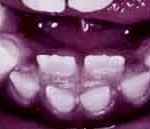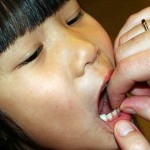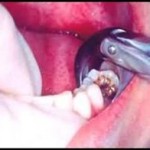All people at some point in their lives will need to have their baby teeth extracted. The primary reason for extracting these teeth is to make room for permanent teeth. Other reasons for extraction are to prevent the crowding of teeth in the mouth, circumvent tooth decay or prevent injury to the inside of the jaw. No matter which of these scenarios describes your circumstances, there are a number of ways to safely extract baby teeth.
Pull the Tooth
One of the more common ways to extract baby teeth is to pull them yourself at home. However, there is one important caveat: The tooth must be free and already loose enough to be lifted out without any pain. Although some people use dental floss as a sort of lasso, there are no special tools needed to extract a tooth at home. If the tooth is loose enough, massage the gum area lightly to further loosen the tooth and provide relief from any pain or discomfort. If the area is tender, administer a bit of aspirin or oral pain-relief gel. You can usually wiggle it around with your fingers for a few seconds each day for about a week, until one day it comes right out. Apply a slow and gradual tug to the tooth. The force the tooth requires is very low; do not use your arm or wrist to apply force, but rather pull with your fingers. It should feel
as if you are merely pinching the tooth rather than actually pulling it. Have the child lean forward if her gums bleed at all following the tooth extraction. This will help prevent her from swallowing blood. Apply pressure to the gums with a new gauze pad to stop bleeding.
Let Your Child Do It
BabyCenter.com advises parents to let the child be the one to pull the tooth. Only your child can determine how much discomfort she can handle. Don’t make your child feel rushed or pressured to remove the tooth. Encourage her to wiggle the tooth with her fingers or to push it back and forth with her tongue. Eventually, the tooth will pull away from the gums, the root will dissolve and the raw, exposed gum underneath will begin to heal, reducing the sensitivity your child feels. Remind your child to wash her hands before she puts them in her mouth. If she is nervous about wiggling her tooth, brainstorm various activities that she can do to take her mind off her tooth, and let it fall out naturally.
Surgical Removal
In more intricate cases, such as when the baby tooth is surrounded by permanent teeth or if all of the permanent teeth have come in and the baby tooth shows no signs of becoming loose, surgical intervention may be necessary. If you are facing this situation, contact your dentist immediately. He will most likely give you a referral to an pedodontist, who will schedule your surgery whenever you are ready. A pedodontist is a dentist who specializes in treating children, especially if the children have special needs, like Down syndrome patients, or very uncooperative children. This is outpatient surgery, so there is no need to plan for a hospital stay. However, you will receive anesthesia to eliminate the pain and pain medicine following the surgery to manage it. During the surgery, the pedodontist will use surgical tools to safely extract the tooth from your mouth.
Let it Fall Out
Perhaps the most pleasant way to extract baby teeth is to simply let them fall out. This option is only available to the lucky few whose baby teeth loosen with ease and do not encounter permanent teeth blocking them in. It is very common for a child to have a loose tooth one night and awaken the next morning only to find the tooth laying on her pillow. There have even been instances where the child is eating and the loose tooth comes out in her mouth while she is chewing. These are actually joyous times, as that means she has once again avoided the trauma of a parent reaching in and pulling the tooth or the possibility of having surgery to remove it.
Why Primary Teeth should be saved
Although all primary teeth are replaced by permanent teeth, this must happen at the right age. There is an appropriate time for each milk tooth to fall and the permanent successor to take its place.
If a milk tooth is lost much earlier than the scheduled time of eruption of the permanent successor, it is likely that space created by loss of the milk tooth will reduce or even close due to drifting of near by teeth. When the permanent tooth erupts it may not have enough space and grow in crooked.
Removal of the front primary teeth should be avoided before the age of 4 years, and the other primary teeth before the age of 9 years. If early removal of teeth is necessary, an appliance called a space-maintainer should be constructed for the child to wear. The function of this appliance is to maintain the space created by the loss of the primary tooth for the permanent successor.


